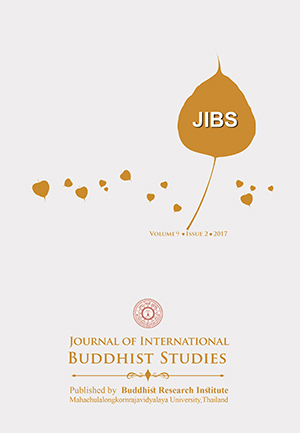Identifying Effective Informal Mindfulness Practices in Daily Activities
Keywords:
Informal meditation, Mindfulness, Contemporary BuddhismAbstract
Mindfulness is a state of consciousness that entails regulating attention to focus on the moment-to-moment experience with an open orientation. The ability to evoke and sustain this state can be cultivated by both formal and informal meditation practices. In the hope of making mindfulness practice more accessible to the fast-paced modern lifestyle, this research explores the possibilities of utilizing modern daily activities as informal mindfulness meditation practices. Through examination of relevant Buddhist texts, along with contemporary studies on the mindfulness, this research outlines the mindfulness state, delineates a four-stage process for practicing mindfulness, and hypothesizes five characteristics of effective mindfulness practice. The four interconnected stages shared by all mindfulness practice are: gathering attention on a single focus, redirecting wandering attention back on the focus and sustaining gathered attention, observing ongoing body and mind activities to focus on the present moment, and finally being mindful of the present moment with the absence on internal chatter. Based on this sketched process of attaining mindfulness, observable mindfulness meditation practices, and relevant literature, five characteristics of effective mindfulness practice are hypothesized: reasonable in time duration, comfortable/pleasurable, limited in sensual inputs, simple/familiar, and repetitive. It is speculated that activities more in line with these five characteristics are more suited for being adopted as activities for informal mindfulness practice, especially for amateur practitioners.
References
Anālayo. (2014). Satipaṭṭhāna. Birmingham: Windhorse.
Baer, R. (2014). Mindfulness-Based Treatment Approaches. London:
Academic Press.
Bishop, S., Lau, M., Shapiro, S., Carlson, L., Anderson, N., &Carmody,
J. et al. (2006). Mindfulness: A Proposed Operational Definition. Clinical Psychology: Science And Practice, 11(3), 230-241. doi: 10.1093/clipsy.bph077
Brown, K., & Ryan, R. (2003). The benefits of being present: Mindfulness and its role in psychological well-being. Journal Of Personality And Social Psychology, 84(4), 822-848.doi: 10.1037/0022-3514.84.4.822
Dane, E. (2010). Paying Attention to Mindfulness and Its Effects on Task Performance in the Workplace. Journal Of Management, 37(4), 997-1018.doi: 10.1177/0149206310367948
Dane, E., & Brummel, B. (2013). Examining workplace mindfulness and its relations to job performance and turnover intention. Human Relations, 67(1), 105-128.doi: 10.1177/0018726713487753
Djikic, M. (2014). Art Of Mindfulness:Integrating Eastern And Western Approaches.The Wiley Blackwell Handbook Of Mindfulness, 139- 148.doi: 10.1002/9781118294895.ch7.
Ericsson, K., &Charness, N. (1994). Expert performance: Its structure and acquisition. American Psychologist, 49(8), 725-747. doi:
1037//0003-066x.49.8.725
Gethin, R. (2011). On Some Definitions Of Mindfulness.Contemporary
Buddhism, 1(12), 263-279.doi: 10.1080/14639947.2011.564843. Hanh, T. (1976). The Miracle of Mindfulness. Boston: Beacon Press. Hanh, T. (1998). The Heart of the Buddha’s Teaching: Transforming Suffer
ing into Peace, Joy, and Liberation (p. 20). New York: Broadway
Books.
Hanh, T. (2011). The long road turns to joy. Berkeley, Calif.: Parallax Press. Hanley, A., Warner, A., Dehili, V., Canto, A., & Garland, E. (2014). Washing
Dishes to Wash the Dishes: Brief Instruction in an Informal Mind fulness Practice. Mindfulness, 6(5), 1095-1103.doi: 10.1007/s12671- 014-0360-9
Ie, A., Ngnoumen, C., & Langer, E. (2014). The Wiley Blackwell Handbook of Mindfulness. Hoboken: Wiley.
Kabat-Zinn, J. (1990).Full catastrophe living. New York, N.Y.: Delacorte Press. Kabat-Zinn, J. (2003). Mindfulness-Based Interventions in Context: Past, Present, and Future. Clinical Psychology: Science And Practice,
(2), 144-156. doi: 10.1093/clipsy/bpg016
Kabat-Zinn, J. (2011).Some reflections on the origins of MBSR, skillful
means, and the trouble with maps.Contemporary Buddhism, 12(1),
-306.doi: 10.1080/14639947.2011.564844
Kendrick, M., Craig, K., Lawson, D., & Davidson, P. (1982).Cognitive and
behavioral therapy for musical-performance anxiety.Journal Of Consulting And Clinical Psychology, 50(3), 353-362.doi: 10.1037/0022-006x.50.3.353
Khazan, I. (2015). Mindfulness and Acceptance-Based Biofeedback. Biofeedback, 43(3), 104-110.doi: 10.5298/1081-5937-43.3.08
Leeming, D. (2014). Encyclopedia of Psychology and Religion. Boston, MA: Imprint: Springer.
Luthans, F., Avolio, B., Walumbwa, F., & Li, W. (2005). The Psychological Capital of Chinese Workers: Exploring the Relationship with Performance. Management And Organization Review, 1(02), 249-271.doi: 10.1111/j.1740-8784.2005.00011.x
Panikkar, B., Brugge, D., Gute, D., & Hyatt, R. (2015). “They See Us As Machines:” The Experience of Recent Immigrant Women in the Low Wage Informal Labor Sector. PLOS ONE, 10(11), e0142686. doi: 10.1371/journal.pone.0142686
Rosenberg, L., &Gaĭ, D. (2004). Breath by breath. Boston, MA: Shambhala. Segal, Z., Williams, J., & Teasdale, J. (2002). Mindfulness-based cognitive
therapy for depression. New York: Guilford.
Shapiro, D., &Zifferblatt, S. (1976). Zen meditation and behavior
self-control: Similarities, differences, and clinical applications. American Psychologist, 31(7), 519-532.doi: 10.1037//0003- 066x.31.7.519
Shiffrin, R., & Schneider, W. (1977). Controlled and automatic human information processing: II. Perceptual learning, automatic attending and a general theory.Psychological Review, 84(2), 127-190.doi: 10.1037/0033-295x.84.2.127
Sun, J., & Ryder, A. (2016). The Chinese Experience of Rapid Moderniza tion: Sociocultural Changes, Psychological Consequences?.Frontiers In Psychology, 7.doi: 10.3389/fpsyg.2016.00477
Teasdale, J., Segal, Z., & Williams, J. (1995). How does cognitive therapy prevent depressive relapse and why should attentional control (mindfulness) training help?.Behaviour Research And Therapy, 33(1), 25-39. doi: 10.1016/0005-7967(94)e0011-7
Thera, N. (1972).The Power of Mindfulness. San Francisco: Unity Press.







